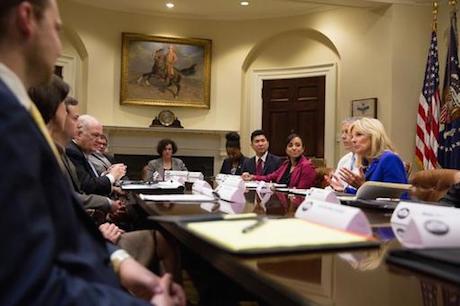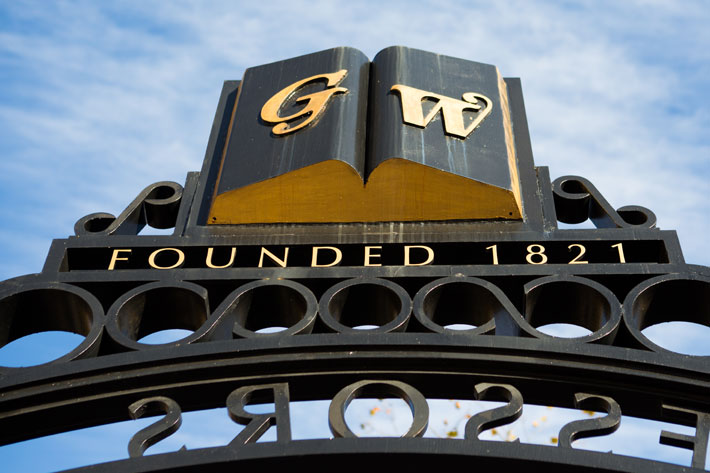The George Washington University has received a record number of admissions applications. University admissions officials report applications for first-year undergraduate students applying to enter for fall 2016 rose an unprecedented 28 percent over the previous year.
As of Jan. 15, GW received 25,431 applications from students who represent all 50 states, the District of Columbia and 142 countries. The university received 19,833 total applications for fall 2015.
Students who chose to apply test-optional accounted for about 20 percent of applications. Officials believe that the university's new test-optional policy was one factor in the rise in applications. Other factors, including the admissions office's targeted outreach to school counselors, a more personalized and data-driven approach to recruitment and a revamped campus visit experience highlighting the university's exceptional academic programs, are all believed to have contributed to the increase.
One element that influenced GW's decision to adopt a test-optional admissions policy was a concern that outstanding academically talented students who did not earn high scores on the SAT or ACT may have felt discouraged from applying. At the same time, studies have indicated that a sustained commitment to a rigorous course of study and exceptional performance in high school academic course work are the best indicators of how a student will fare in college.
In the first year since implementing the test-optional policy, GW has seen a significant increase in applications from students who are from underrepresented groups, including African-American, Latino and international students and first-generation college students. Officials also noted that applications from first-generation college students increased by nearly 1,100.
"We adopted our test-optional policy to strengthen and diversify an already outstanding applicant pool by reaching out to exceptional students who have been underrepresented at selective colleges and universities," said GW President Steven Knapp. "These initial results suggest that our efforts are on the right track."
Early Decision Indicators Show Increased Quality and Interest
Along with an increase in total applications, early decision applications for fall 2016 rose more than 30 percent over 2015 with 1,373 applying compared with 1,046 the previous year. GW sent decisions to students who applied Early Decision I in December 2015 and will notify Early Decision II applicants in the coming weeks. Students who applied regular decision will be notified in late March.
GW is slated to accept 841 early decision applicants for fall 2016 compared with 780 for the class that entered in fall 2015. The students GW accepted for early decision have a median and mean GPA that is slightly higher than the early decision class the previous year.
"While the class that will officially enroll next fall will be determined in the coming months, the high GPA from our early decision students is an early sign that GW is on its way to enrolling its strongest and most academically gifted class to date," said Laurie Koehler, vice provost for enrollment management and retention. "We are excited to see such a diverse group of applicants who feel that GW is a great fit for them."
The GW admissions team will work throughout the spring to enroll a first-year class of 2,500 to 2,600 students. Last fall, 2,574 first-year students enrolled at the university.
A University Focus on Access
The test-optional policy was the first of many initiatives the university has undertaken in the last year to improve access to a college education for students from all backgrounds.
In December 2015, GW launched the District Scholars Award, a grant that will expand college access to District of Columbia high school students to ensure that accepted D.C. students from families with annual household incomes at or below $75,000 can attend GW.
In October 2015, the university announced a partnership with The Posse Foundation, a nationwide college access and youth leadership development program, to offer full-tuition leadership scholarships to select Atlanta-area public high school graduates. In September 2015, GW joined with the nonprofit organization Say Yes to Education to provide full-tuition scholarships for public high school students from participating chapters in New York and North Carolina whose annual family income is at or below $75,000.
These initiatives are in response to recommendations from the university's Task Force on Access and Success, formed in January 2014 following Dr. Knapp's participation in the White House Summit on College Opportunity.
Other college access initiatives at the university include the Gil and Jacki Cisneros Institute, which offers a pre-college program to high school juniors who are committed to leadership and service within the Hispanic community and the Native American Political Leadership Program INSPIRE, offering a pre-college program to Native American, Native Alaskan and Native Hawaiian high school students.
Finally, as part of the university's Making History campaign, GW has set a goal to raise at least $200 million to continue to ensure that qualified students, regardless of financial resources, can take full advantage of a GW education.





